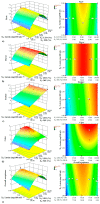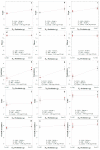Development of a Novel Low-Calorie Lime Juice-Based Prebiotic Beverage Using a Combined Design Optimization Methodology
- PMID: 36766208
- PMCID: PMC9914248
- DOI: 10.3390/foods12030680
Development of a Novel Low-Calorie Lime Juice-Based Prebiotic Beverage Using a Combined Design Optimization Methodology
Abstract
A novel lime-juice based low-calorie functional beverage was developed by using D-optimal combined design optimization. For the preparation of the beverage, the following functional ingredients were used: lime juice, lime peel essential oil (LEO) as a flavoring agent and bioactive component, sucralose as a low-calorie sweetener, an inulin/polydextrose (I/P) mixture as prebiotic fibers, pectin as a thickening agent and soluble dietary fiber, lutein as a carotenoid colorant and antioxidant, and peppermint extract (ME) as a flavoring agent and bioactive component. A combined design consisting of one mixture factor (LEO/ME ratio), one numeric factor (lutein concentration), and one categoric factor (presence or absence of prebiotics) was used for optimizing the functional beverage based on the sensory quality. Regression models were adequately fitted to the data of sensory acceptance with a determination coefficient >90%. The sample containing a mixture of prebiotics, 2:3 (v/v) ratio of LEO: ME, and 3 mg/100 mL lutein was selected as the best formulation among the six optimal beverages which was suggested by Design-Expert software. This final optimum sample showed the highest total phenolic (44.22 mg gallic acid equivalents/L) and flavonoid (25.49 mg quercetin equivalents/L) contents, and its antioxidant activity (as 2,2-diphenyl-1-picrylhydrazyl radical (DPPH•) scavenging) was 38.30%. The newly designed beverage has the potential to promote health benefits and in therapeutic applications.
Keywords: high-fiber prebiotic beverage; lime peel essential oil; lutein; optimization; peppermint extract.
Conflict of interest statement
The authors declare no conflict of interest.
Figures





References
-
- Edwards C.H., Rossi M., Corpe C.P., Butterworth P.J., Ellis P.R. The role of sugars and sweeteners in food, diet and health: Alternatives for the future. Trends Food Sci. Technol. 2016;56:158–166. doi: 10.1016/j.tifs.2016.07.008. - DOI
LinkOut - more resources
Full Text Sources
Research Materials

